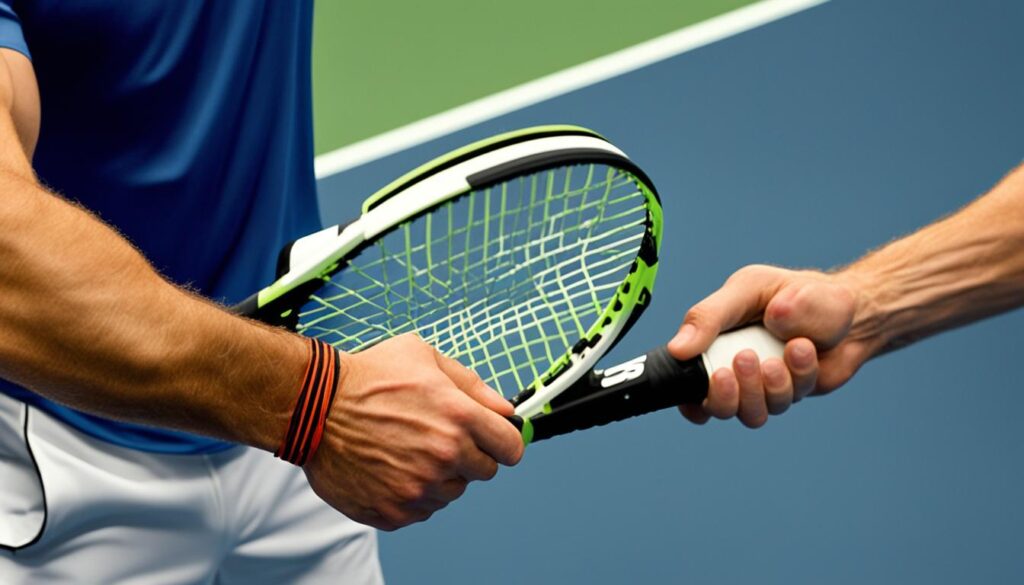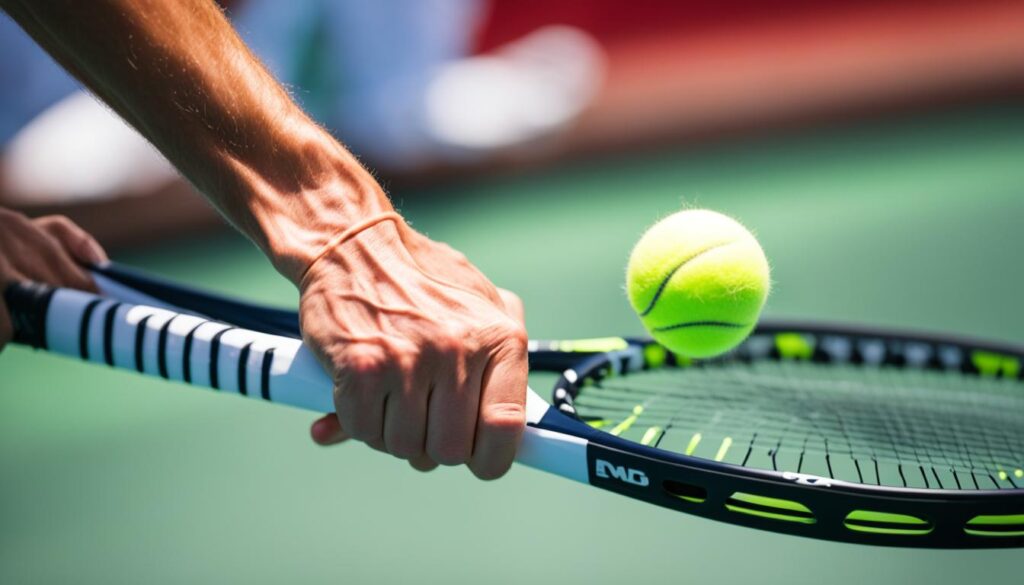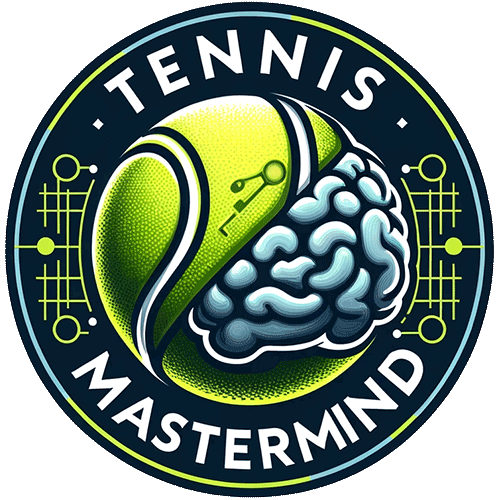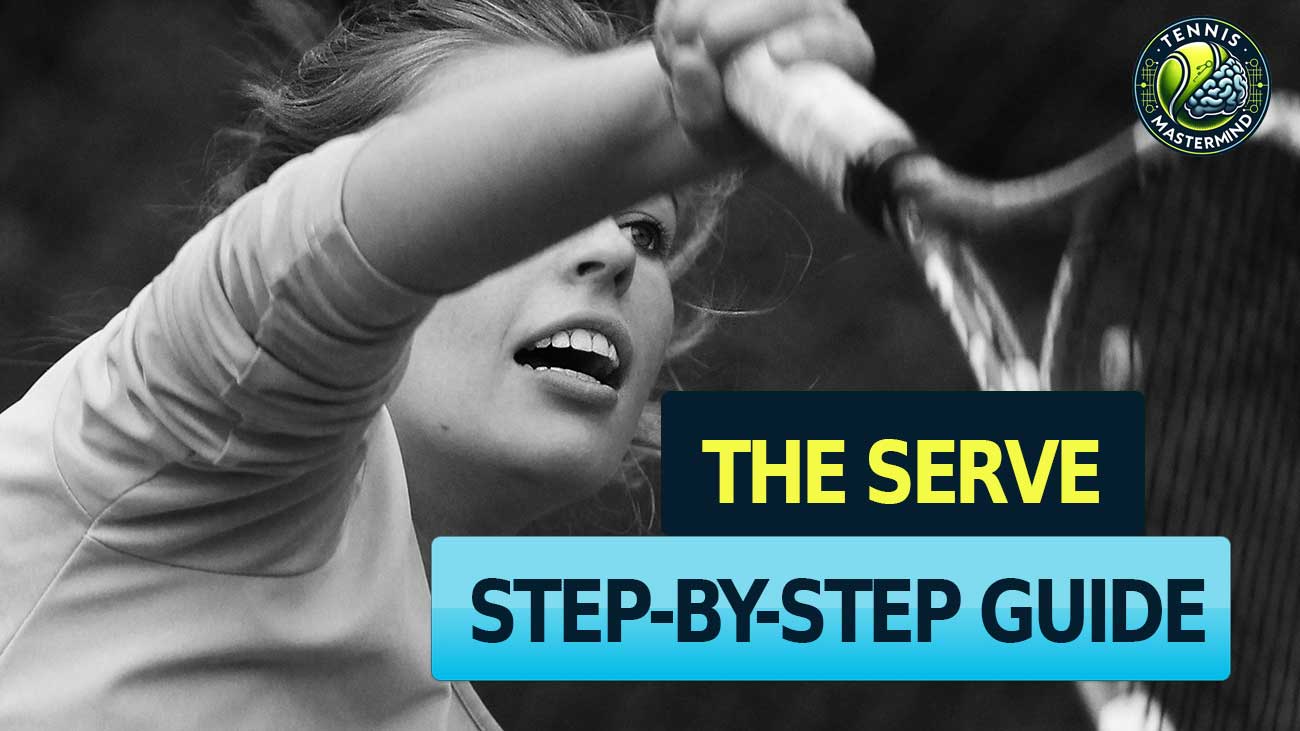A tennis serve is a crucial shot in the game, but it can be challenging to master. To serve effectively, beginners must focus on learning the correct technique step by step. This involves understanding the proper stance, grip, and hitting mechanics. By following the right progressions, beginners can improve their serve and make it a weapon rather than a liability on the court.
Key Takeaways:
- Mastering the tennis serve takes dedication and practice.
- Focus on fundamentals like stance, grip, toss, and swing mechanics.
- Use online resources for valuable insights and training exercises.
- Consistency is key for serving improvement.
- Commit to the journey of serve mastery and elevate your game.
The Stance and Footwork: Setting the Foundation
The first step in perfecting your tennis serve is establishing the correct stance and footwork. By adopting the right position on the court, you can set a strong foundation for a successful serve. Let’s delve into the details of the tennis serve stance and the importance of serving footwork.
The Basic Stance
For beginners, it is recommended to start with a basic stance. In this stance, the front foot should point towards the right net post (for right-handers), while the back foot remains parallel to the baseline. This positioning allows for balance in all directions, enabling you to execute a smooth and controlled serve.
The Platform Stance
One type of tennis serve stance is the platform stance. With this stance, both feet remain in the same position throughout the serve. The platform stance provides stability and allows for consistent weight transfer during the serving motion. It is commonly used by players who prefer a more straightforward and powerful serve.
The Pin-Point Stance
Alternatively, the pin-point stance involves moving the back foot closer to the front foot during the swing. This stance helps generate more hip rotation and enables advanced players to add extra power and spin to their serves. The pin-point stance is often chosen by players who prioritize versatility and the ability to hit a wider range of serves.
“The right tennis serve stance is crucial for a strong and controlled serve. Whether you opt for the platform or pin-point stance, it’s important to find the one that suits your style and maximizes your serving potential.”
Having a solid foundation through the correct tennis serve stance and precise footwork is essential for executing a powerful and accurate serve. Mastering these fundamentals will boost your confidence and form the basis for further improvement in your serve technique.
Now that we have laid the groundwork with the stance and footwork, let’s explore the next vital element in serving mastery: the grip.
The Grip: Foundation for Power and Precision
When it comes to mastering your tennis serve, the grip you choose plays a crucial role in generating power and precision. A proper grip sets the foundation for a strong and effective serve. For beginners, the recommended grip is the continental grip.
The continental grip involves holding the racket like a hammer, with the edge perpendicular to the ground. This grip allows for greater control and versatility in your serve. To ensure you have the correct grip, place your left index finger in the valley between the thumb and index finger of your right hand (for right-handers).

The continental grip affects various aspects of your serve, including pronation and a loose swing. It allows for optimal pronation, which is the natural rotation of the forearm that generates power in the serve. Additionally, the grip facilitates a loose swing, enabling a fluid motion and preventing tension in your arm.
Mastering the continental grip takes practice and repetition. One way to reinforce the grip is by performing shadow swings without the ball, focusing on the correct hand positioning and grip pressure. Incorporating grip strengthening exercises, such as squeezing a tennis ball, can also enhance your grip stability.
“The right grip is the foundation for a powerful and accurate serve. With the continental grip, you’ll have greater control over your shots and the ability to generate the desired pace and spin.” – Coach Sarah Johnson
Grip Techniques and Variations
While the continental grip is the recommended starting point for beginners, it’s essential to explore different grip techniques and variations as you progress in your serve development. Here are a few grip variations that players commonly use:
- Eastern Forehand Grip: This grip is slightly more relaxed than the continental grip and offers more topspin potential. It’s commonly used in baseline serves and allows for greater racket head speed.
- Western Forehand Grip: Also known as the extreme topspin grip, this grip is ideal for players who want to generate significant topspin on their serves. It requires a deeper understanding of racket control and can be more challenging for beginners.
- Serve-and-Volley Grip: This grip is commonly used by players who employ a serve-and-volley strategy, meaning they serve aggressively and follow it up with a quick approach to the net. It combines elements of the continental and Eastern forehand grips.
Exploring different grip techniques and variations can help you discover what feels most comfortable and suits your playing style. Remember to practice each variation with precision and consistency to develop muscle memory and coordination.
Grip Checklist for a Powerful Serve
Here’s a quick checklist to ensure you have the proper grip for a powerful and precise serve:
- Hold the racket with a continental grip, aligning the edge perpendicular to the ground.
- Place your left index finger in the valley between the thumb and index finger of your right hand (for right-handers).
- Ensure a loose grip to enable a relaxed swing and optimal pronation.
- Practice grip strengthening exercises to improve grip stability.
- Explore different grip techniques and variations to enhance your repertoire.
The grip is the foundation of your tennis serve, providing the necessary power and precision. By mastering the continental grip and experimenting with other grip techniques, you’ll have the tools to elevate your serve and dominate on the court.
The Toss: Elevating Consistency and Control
The toss is a crucial element in achieving a consistent and controlled tennis serve. Improving your toss technique can significantly impact the success of your serve. Here are some tips to enhance your toss:
- Stay loose in your arm: Maintaining a relaxed arm during the toss helps ensure a smooth and fluid motion. Avoid tensing up, as it can affect the accuracy and height of the toss.
- Avoid setting a ground target: Instead of fixating on a specific spot on the ground, focus on releasing the ball at the desired height. This allows for better control and adaptability during the serve.
- Practice against a wall or fence: Practicing your toss against a wall or fence can help you refine your technique. It provides a visual reference point and allows you to adjust the toss based on the ball’s trajectory.
Variations in the toss can also be utilized strategically to add complexity and surprise to your serve. Experimenting with different heights and spins can keep your opponent guessing and make it harder for them to read your serve.
Mastering the toss is essential for consistent and controlled serving. It sets the foundation for a powerful and accurate serve. Remember to stay loose, avoid targeting the ground, and practice against a wall or fence. Incorporating toss variations can also add that extra edge to your serve. By honing your toss technique, you can elevate your serve to new levels of consistency and control.
We’ve all had our fair share of toss mishaps, but with practice and focus, we can overcome these challenges and unleash our full serving potential.
Swing Mechanics: From Wind-Up to Contact
The swing mechanics of the serve play a pivotal role in generating power and precision. Mastering the proper technique from the wind-up to the contact point can significantly enhance your overall serve performance. Let’s explore the key elements of the swing mechanics that will help you elevate your tennis serve game.
The Wind-Up: Building Energy for an Explosive Serve
The wind-up is the initial phase of the serve where you coil your body and bend your knees to build energy. This coiled position is essential for generating power and maximizing the racket head speed. To execute a solid wind-up, begin by standing sideways on the baseline with your feet shoulder-width apart. As you start the serve motion, rotate your hips and shoulders while bending your knees. This wind-up position will store potential energy, allowing for a dynamic and explosive forward swing.
The Contact Point: Aiming for Consistency and Precision
The contact point is where the magic happens—the moment when the racket meets the ball. Achieving a consistent contact point is crucial for a reliable and accurate serve. Aim to make contact with the ball at the optimal point of the swing, commonly known as the sweet spot. This sweet spot is located slightly in front and above your dominant shoulder. By consistently hitting the ball at this ideal contact point, you increase your chances of a well-placed and powerful serve.
Adding Spin to Your Serve: Strategic Advantages and Guessing Opponents
Adding spin to your serve can provide you with a strategic advantage and keep your opponents guessing. There are various spin types you can incorporate into your serve, such as slice, topspin, or kick. Each spin type has unique characteristics and can be used strategically during a match. For example, a topspin serve can help you keep the ball in play and create a dipping trajectory, making it difficult for your opponent to return effectively. Experimenting with different spins and mastering their execution will add versatility and effectiveness to your serve arsenal.

Now that we’ve covered the key swing mechanics of the tennis serve, you have a solid foundation to master this essential shot. The wind-up, contact point, and spin variations are vital elements that, when practiced and perfected, can take your serve to the next level. Keep refining your technique and enjoy the rewards of a powerful, accurate, and well-spun serve on the court.
Conclusion: Acing Your Journey to Serve Mastery
Improving your tennis serve is a journey that requires dedication and practice. By following the steps outlined in this article, beginners can develop a powerful and accurate serve. It’s important to focus on the fundamentals, such as the stance, grip, toss, and swing mechanics.
Consistent practice is key to tennis serve improvement and should be complemented by proper serve training. Utilizing resources like online tennis instruction can provide valuable insights and training exercises to enhance your skills. Engaging in targeted serve training drills can help you refine your technique and build muscle memory, leading to serve mastery.
Remember, mastery of the tennis serve doesn’t happen overnight. It takes time, patience, and a commitment to improvement. Make serve training a regular part of your practice routine and monitor your progress. Celebrate small victories along the way, as each incremental improvement brings you closer to your goal of serve mastery.
So, pick up your racket, head to the court, and embark on the journey to improve your tennis serve. With dedication, practice, and a focus on the essential aspects of the serve, you can deliver powerful serves and gain a significant advantage in your matches. Together, let’s elevate our game through serve mastery!




